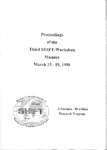Por favor, use este identificador para citar o enlazar este ítem:
http://www.alice.cnptia.embrapa.br/alice/handle/doc/668385Registro completo de metadatos
| Campo DC | Valor | Lengua/Idioma |
|---|---|---|
| dc.contributor.author | MARINO, W. T. | pt_BR |
| dc.contributor.author | SILVA JUNIOR, J. P. da | pt_BR |
| dc.contributor.author | MARSCHNER, P. | pt_BR |
| dc.contributor.author | LIEBEREI, R. | pt_BR |
| dc.date.accessioned | 2014-12-12T08:17:05Z | - |
| dc.date.available | 2014-12-12T08:17:05Z | - |
| dc.date.created | 1999-09-29 | pt_BR |
| dc.date.issued | 1998 | pt_BR |
| dc.identifier.citation | In: SHIFT-WORKSHOP, 3., 1998, Manaus. Proceedings... Bonn: BMBF, 1998. | pt_BR |
| dc.identifier.uri | http://www.alice.cnptia.embrapa.br/alice/handle/doc/668385 | pt_BR |
| dc.description | One hyndred sixty-eight bacterial isolates from the rhizoplane and rhizosphere (2mm-10mm away from the root surface) of cupuacu were isolated in spring 1997 in an experimental polyculture site (SHIFT ENV-23) near Manaus and their capacity to grow on media with poorly soluble AlPO4 was determined. 75% of the isolated bacteria were found to be effective in solubilizing hardly-soluble AlPO4 and FePO4. Two strains were selected because of their ability to solubilize high amounts (>50ug P/ml) of AlPO4 and FePO4 in former experiments. Their capacity to solubilize inorganic phosphates was investigated in liquid culture. Both strains solubilized similar amounts of P. The amount of P solubilization was highest after three days of growth while cell numbers were maximal after 13 days. During the solubilization process one strain show a decrease in pH while the other strain increased the pH. This incates that the solubilization of inorganic phosphates is not necessarily related to the acidification. | pt_BR |
| dc.language.iso | eng | eng |
| dc.rights | openAccess | eng |
| dc.subject | Agrofloresta | pt_BR |
| dc.subject | Brasil | pt_BR |
| dc.subject | Amazonas | pt_BR |
| dc.subject | Manaus | pt_BR |
| dc.title | Solubilization of Al- and Fe-phosphates by bacteria isolated from the rhizosphere of Theobroma grandiflorum (Willd. ex Spreng.) Schum. | pt_BR |
| dc.type | Artigo em anais e proceedings | pt_BR |
| dc.date.updated | 2018-08-13T11:11:11Z | pt_BR |
| dc.subject.thesagro | Bactéria | pt_BR |
| dc.subject.thesagro | Cupuaçu | pt_BR |
| dc.subject.thesagro | Cultivo Multiplo | pt_BR |
| dc.subject.thesagro | Rizosfera | pt_BR |
| dc.subject.thesagro | Theobroma Grandiflorum | pt_BR |
| dc.subject.nalthesaurus | agroforestry | pt_BR |
| dc.subject.nalthesaurus | multiple cropping | pt_BR |
| dc.format.extent2 | p. 341-349. | pt_BR |
| riaa.ainfo.id | 668385 | pt_BR |
| riaa.ainfo.lastupdate | 2018-08-13 -03:00:00 | pt_BR |
| dc.contributor.institution | University of Hamburg | pt_BR |
| dc.contributor.institution | JOSE PEREIRA DA SILVA JUNIOR, CPAA. | pt_BR |
| Aparece en las colecciones: | Artigo em anais de congresso (CPAA)  | |
Ficheros en este ítem:
| Fichero | Descripción | Tamaño | Formato | |
|---|---|---|---|---|
| Shift341.pdf | 6.68 MB | Adobe PDF |  Visualizar/Abrir |









